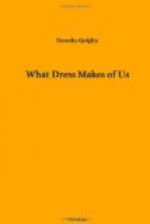The tall, thin sisterhood should eschew pointed effects and study to attain apparent breadth by using trimmings arranged horizontally. Bands of velvet, braid in waved lines, ruffles, and not too deeply cut scallops, may be used effectively by the very slender, who sometimes appear as if they are “without form and void,” as the earth was “in the beginning.”
[Illustration: No. 51]
No. 51 is an exposition of the mistake made by the sturdy sisterhood of stout and pendulous proportions. It is plain to be seen that the fluffy ruche at the throat-band, and the ruffle at the shoulder, and the spreading bow at the waist, and the trimmed sleeves, add bulkiness to a form already too generously endowed with flabby rotundity. Corpulent women must forego the swagger little basques or any sort of short, flounced effects below the waist-line.
[Illustration: No. 52]
[Illustration: No. 53]
Nos. 52 and 53 are eminently adapted to the matron of ample dimensions. One observer of beauty-giving effects has not unadvisedly called the waist-line “the danger-line.” A stout sister, above all others, should not accentuate the waist-line. She should conceal it as much as possible. The coat back of No. 52 apparently lengthens the waist.
The same effect is produced by the arrangement of ribbons in No. 53, and by the long-pointed basque. V-shaped effects and long-pointed basques are as becoming to those burdened with flesh as they are unbecoming to tall, thin women.
Long, graceful folds and draperies are admirable for the stout sisterhood, who should avoid short sacques and tight-fitting garments that give the on-looker an uncomfortable impression; there is too much in a small space. Very light colors and thin textures that billow and float should be eschewed by the large, fleshy woman who wishes to give the impression that she possesses the lines of a finely modelled statue. She should avoid puffs and any suggestion of the pulpy and clumsy, and be careful not to sub-divide the body of her dress by plaits or braids laid on horizontally across or above the bust, or below the hips. Horizontal lines invariably decrease the height; for that reason stout women should not wear dresses cut square in the neck, but should adhere to the graceful V-or heart-shaped cut which has a tendency to give length.
The rotund woman with a short waist, sketched in No. 54, may improve her figure, as shown in No. 55, by choosing belts and collars the exact shade of her shirt-waists in summer, and by not cutting off her height by any sort of outside belt on winter gowns.
[Illustration: No. 54]
[Illustration: No. 55]
Tall, stout women should forego high heels on their shoes, high hats, and striped dresses. Although stripes increase the effect of height, they also add to that of breadth. A plain cloth basque and skirt of striped material make a happy compromise and can be worn with becoming effect by a stout woman.




